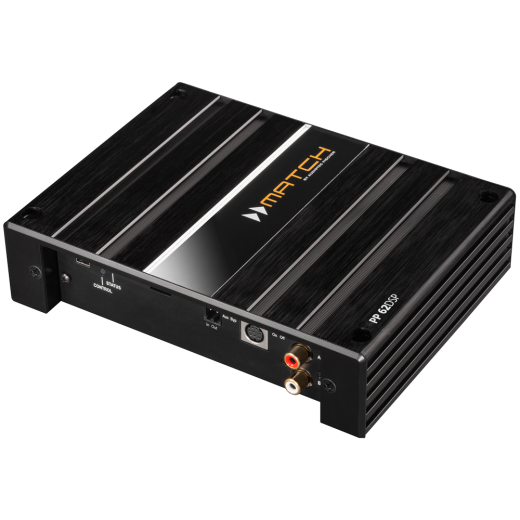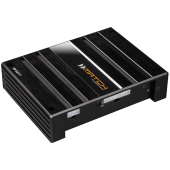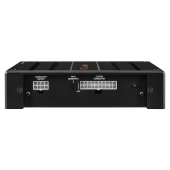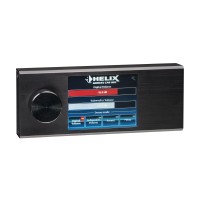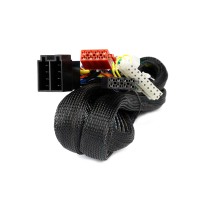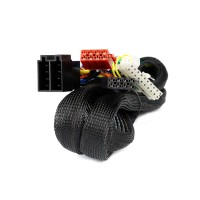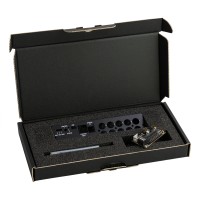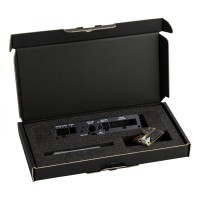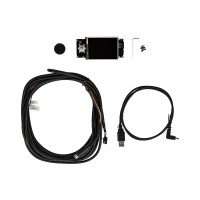Amplifier with DSP Match PP 62DSP
6-channel amplifier with DSP processor, 4 x 35 / 2 x 70 into 4 Ω / 4 x 50 + 1 x 160 W RMS into 2 Ω, class A
More about the product
More about the product
Amplifier with DSP Match PP 62DSP
The Match PP 62DSP is a state-of-the-art amplifier with a DSP processor for easy installation with the Plug & Play system. It connects to the original speaker system, from which it is able to extract the maximum possible quality of presentation and performance. (The original units are usually bad with sound). It also adds the ability to easily connect one of three types of subwoofers, which adds even more depth to the overall sound. Production and development takes place in Germany by a family company with more than 28 years of tradition.Unique feature
This device combines maximum compatibility and simple installation. Complete connection wiring is included in the package, so there is no need to cut or modify anything. To connect to your car, you just select the right connector from the database. The option to upload settings directly to the amplifier is also unique. There is a comprehensive database of ready-made tuned cars available, which can be easily used for free and uploaded to the device using a micro SD card. The PP 62DSP also offers other expansion options using the MEC (Match Extension Card) and connecting a Bluetooth module or High Resolution Audio USB to this device, which will enable playback in the highest possible quality. Each device then has a cinch output for connecting an additional amplifier.MEC HD - module for playing music in the highest quality
Even the most demanding users will find their way here. Thanks to the professional and user-friendly interface of the DSP PC-Tool software, individual settings become amazingly simple. So if you can't find the exact settings for your car in the database, or you just want to fine-tune it to your liking, this amplifier is exactly for you.Absolutely no impact on the car!
Modern high-level ADEP.2 inputs ensure perfect functionality for Match brand products even in the latest cars. This is because some cars have a speaker sensor and recognize incorrect connections and turn off the signal. This then leads to signal problems for the external amplifier. Thanks to the energy saving mode, the device automatically switches off after 60 seconds when there is no input signal. In cars with a CAN bus, the device can remain "invisible" on for up to 45 minutes. However, the consumption is reduced to 0.25 A. This means that there are absolutely no problems with the original electrical installation and battery discharge.MATCH expansion card slot
The functionality of the MATCH PP 62DSP amplifier can be expanded by inserting an optional MATCH expansion card (MEC) - for example, a Bluetooth ® Audio Streaming module, an optical digital input or an AUX input.Intelligent high-level input ADEP.2
The latest generation of original car radios includes sophisticated diagnostic options for connected speakers. If a regular amplifier is connected, the result is often error messages and loss of specific functions (e.g. fader function). Additionally, new power stage designs in some radios can cause asymmetric output signals that lead to distortion in AD converters. The new ADEP.2 (Advanced Diagnostics Error Protection, 2nd generation) circuit avoids all these problems without unnecessarily loading the OE radio's speaker outputs at high volume.Power saving mode
Power saving mode allows the PP 62DSP (and any other connected amplifiers) to significantly reduce power consumption if there is no input signal for more than 60 seconds. When "Power Save Mode" is active, the PP 62DSP's internal amplifier stages and the remote output are switched off, significantly reducing power consumption. The amplifier will return to normal operation within 2 seconds as soon as there is a music signal at its input. The switch-off delay can be changed or completely disabled using the DSP PC-Tool software.
MicroSD
A MicroSD card reader enables easy DSP configuration inside the amplifier without the need for a direct PC connection. A large number of car-specific settings are available free of charge at www.audiotec-fischer.com. Simply download the setup you want and copy it to any MicroSD card. Finally, insert the MicroSD card into the PP 62DSP and the copying process will start automatically. The amplifier is then perfectly programmed to dramatically improve the sound quality of your factory car audio system.Key properties
- Very simple Plug & Play connection to original sound systems using vehicle-specific adapter cables.
- MATCH expansion card (MEC) slot for additional input modules such as Bluetooth ® audio streaming, USB high-definition audio streaming, etc.
- Powerful "Fixed Point" audio DSP with 56-bit resolution.
- Extensive database of vehicle-specific settings available online.
- Optionally configurable as a 6-channel amplifier with a total of 8 DSP channels.
- Freely configurable 2-channel PreOut output for connecting additional amplifiers.
- Adjustable input sensitivity (control range 11V to 5V).
- Automatic remote switch.
- Intelligent high-level input with ADEP circuit.2.
- High level input EQ.
- Connection for optional wired remote control, functions configurable via PC software.
- State-of-the-art SMD technology for reduced construction and maximum reliability.
- Printed circuit boards in 4x multi-layer technology for optimal performance and signal transmission.
Package contains
- 1x Match PP 62DSP amplifier.
- 1x USB cable.
- 1x PP-ISO 2 cabling (2.2 m length).
- 1x mounting material.
- 1x instruction manual.
| Catalog number | PP 62DSP |
| Brand | Match |
| Links | Official web presentation |
| Number of amplifier channelsAmplifiers are divided into: - Monoblocks - 2-channel - 3-channel - 4-channel - 5-channel - 6-channel - multi-channel Each channel is used to power one speaker for the coaxial type, or one side if they are component speakers. Monoblock type amplifiers are mainly used for subwoofers. 2-channel are suitable for both subwoofers and, for example, the front pair of speakers in a car. 3-channel is used for front or rear speakers + subwoofer. 4-channel are used for front + rear speakers or 1 pair of speakers + subwoofer. 6 or 5-channel are used for 2 pairs of speakers + subwoofer, most often. Bridging means connecting the amplifier to a bridge, using the + pole from one channel and the - pole from the other channel. In most cases this is shown as "BRIDGED" on the amplifier. | 6 |
| Energy class of the amplifierAmplifiers are divided into two basic classes: analog and digital . Analog amplifiers (A/B) have higher consumption requirements, but usually have a more natural sound. Digital amplifiers (D) have significantly lower consumption and higher efficiency, but the sound may not be as faithful as with classic analog amplifiers. | D |
| RMS power into 4 ΩRMS power when loading speakers or subwoofer at 4 Ω. RMS power is the constant power of the amplifier and is one of the most important parameters when choosing an amplifier. | 4 x 35 / 2 x 70 W |
| RMS power into 2 ΩRMS power when loading speakers or subwoofer at 2 Ω. RMS power is the constant power of the amplifier and is one of the most important parameters when choosing an amplifier. | 4 x 50 + 1 x 160 W |
| Max. (maximum) power at 4 ΩPeak performance "Max." , which the amplifier can develop for a very short time. A relatively unimportant parameter. It is mainly a marketing move to attract customers to high numbers. | 4 x 70W |
| Max. (maximum) power at 2 ΩPeak performance "Max." , which the amplifier can develop for a very short time. A relatively unimportant parameter. It is mainly a marketing move to attract customers to high numbers. | 4 x 100 + 1 x 320 W |
| Frequency rangeThe ability of the amplifier to reproduce the signal from the lowest frequency to the highest = faithfully reproduce the sound in a specific frequency band. Professionally: In the frequency range from 40 to 16,000 Hz, the vast majority of fundamental and overtones (harmonics) of all musical instruments are found. We are interested in the course of the radiated sound pressure in this range of frequencies when the loudspeaker system is supplied with constant power. We call this course the frequency characteristic, which tells us the level of radiated sound pressure in decibels (dB) depending on the frequency. The frequency characteristic of a speaker or speaker system can be expressed most succinctly with a graph. Mostly, however, the frequency characteristic is indicated by indicating the maximum tolerance of the sound pressure in the given frequency range, e.g. 50 to 15,000 Hz -+ 6 dB. Since the frequency characteristics of loudspeakers and systems in general are quite uneven, some manufacturers do not even specify this maximum tolerance of sound pressure in decibels in their catalogs for reasons of prestige. Data impoverished in this way is unfortunately worthless. What is valid is that the manufacturer offers a speaker system with a frequency range of 30 to 20,000 Hz, if he is worried about stating the maximum unevenness of the sound pressure in this range, because he can have a tolerance of, for example, +- 20 dB. The unevenness or undulation of the frequency curve in good speaker systems for high-quality music performance should not exceed +-3 dB in the 80 to 12,000 Hz band and +-6 dB in the 40 to 16,000 Hz band. Greater unevenness already depletes or emphasizes certain tonal areas, which can cause audible or even disturbing distortion. The proportion between fundamental tones and higher harmonics also changes, thereby changing the color of the sound, and individual musical instruments as well as the entire musical image sound unnatural. | 20 - 22000 Hz |
| Harmonic Distortion (THD)Total harmonic distortion indicates how much the input signal is distorted in the amplifier. Distortions appear as overtones contained in the output signal. The proportion of originally absent parts of the signal is given as a percentage, typical values are between 0.001% and 0.5%. Distortion is measured in their power band. If it exceeds the limit of 0.7% from a certain power, it is the value of the output power of the given amplifier, from which it no longer plays without distortion and from which the distortion usually increases steeply, so that no further increase in power can be counted on. The lower the value, the better. | < 0.01% |
| Signal-to-noise ratioThe signal-to-noise ratio means that the output signal always contains noise. The signal-to-noise ratio expresses how much of this noise is compared to the useful signal. The so-called A value is given, which does not take deep and very high frequencies into account. This corresponds to the characteristic of human hearing, which is not so sensitive to deep frequencies, especially below 1 kHz. The higher the value, the better the amplifier is. | 103 dB |
| Input sensitivityIn order for the amplifier to perform its function correctly, it requires an input signal of a certain level, which is different for car radios. It is measured in "Volts" (e.g. 2 V, 4 V, etc.) The higher the value at the output of the pre-amplifier, or car radio, the less demands are placed on the power of the amplifier. However, the amplifier must allow this input sensitivity, and for that reason this value is also given for the amplifier. | 5 - 11 V |
| Damping factorDF - Damping Factor . It is the ratio of the load (repro + cables, crossover, etc.) to the internal resistance of the amplifier. The bigger the DF, the more controlled the bass. Amplifiers with a lower DF tend to hum. Subwoofers with a higher Q in the bass reflex and sometimes in the enclosure will also cause humming. | > 100 |
| High level inputsThe high-level input on the amplifier allows connection directly to the existing speakers in the car without additional purchase of an external high/low adapter. Important equipment in the case of installing an amplifier on an original car radio. | Yes |
| Automatic on and offThis function allows you to automatically switch on the amplifier. | Yes |
| Socket input terminalsFerrule terminals allow better wiring contact to the amplifier. It is also a more secure form of terminals. If you are tightening the sleeve terminals, we recommend retightening them after 1 day, as the connected cable gradually compresses. | No |
| Remote control included in the packageSome models of amplifiers also come with wired remote controls in the package, which on one side plug into the amplifier and on the other side you have a potentiometer that you can place anywhere in the cabin. A common place to place the remote control is under the steering wheel. The advantage is the regulation of power, and therefore volume, depending on driving conditions and the mood of the crew in the car. | No |
| Input for wired remote controlIf the amplifier has a remote control input. | Yes |
| The value of the fuses on the amplifierFrom the value of the fuses on the amplifier, you can get a true picture of the real performance of the amplifier. | 1 x 20 A MAXI |
| Dimensions of the amplifier | 185 x 44 x 139 mm |
Product comments
Evaluation
ask us
